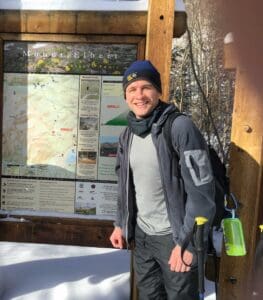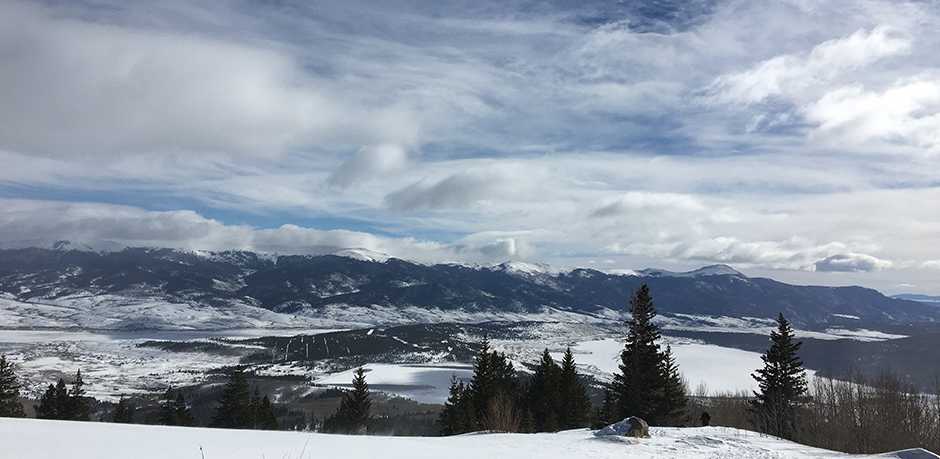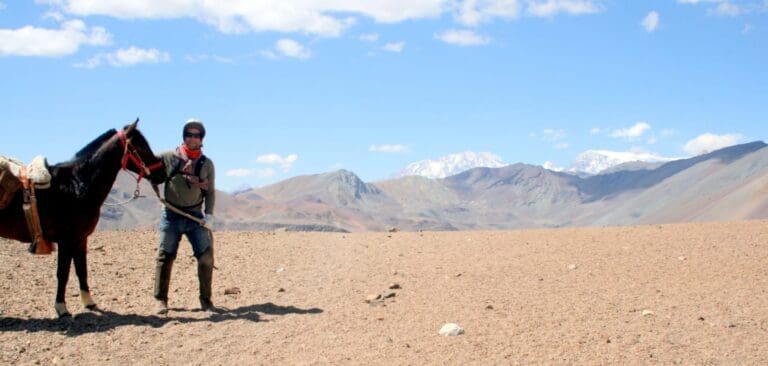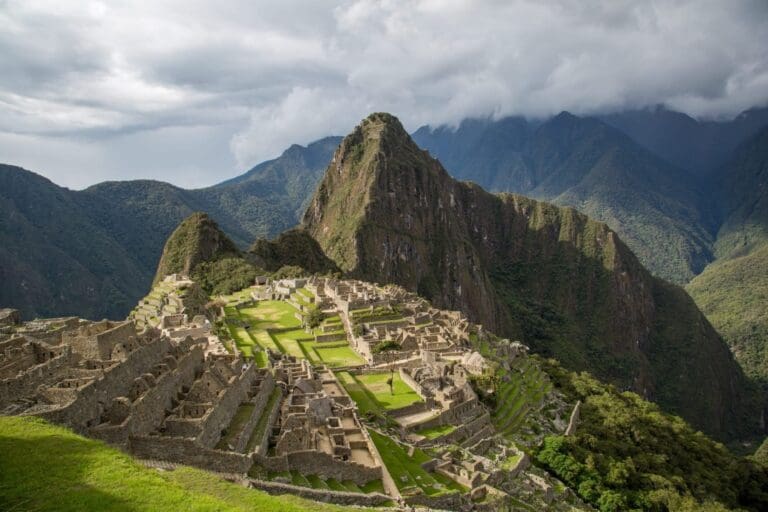Hiking at High Altitudes: 5 Things to Consider
In February 2016, my adventure buddy David said he’d be in Colorado for a few weeks and asked if I wanted to join him for some Rocky Mountain high altitude climbing. Never to turn down an adventure, I jumped at the opportunity and booked my flights. The focus quickly turned to which mountain to climb. Over the past few years I have been checking off state high points one by one, and this seemed like a great opportunity to add Colorado to my list. But little did we know that that Mount Elbert, the highest mountain in Colorado, would have different plans for us on this adventure getaway.
The Highest Mountain in the Rockies
Mount Elbert is a little over 2 hours southwest of Denver. Standing at 14,439 feet (4,401 meters), it is both the highest mountain in the entire Rocky Mountain range and the 2nd highest mountain in the lower 48 states. While hiking Mt Elbert in the winter seems a bit ambitious, the South Mount Elbert Trail leading to the summit is relatively easy and requires little if any technical climbing. The mountain, however, poses plenty of danger. While avalanche risk when climbing Mount Elbert is considered low, the volatile weather and extreme elevation can pose serious risks for even the most seasoned hikers.
The Adventure Begins

We arrived at the South Mount Elbert trailhead at 7:00 AM on a beautiful winter morning with not a cloud in the sky. Weather forecasts consistently pointed to clear weather, providing us a perfect window for us to attempt our summit. Our planned route along the South Mount Elbert trail was 11 miles (17.7 kilometers) round trip. The mountain was covered with snow but we came prepared with micro-spikes and snowshoes for traction.
At the trailhead we met a fellow hiker from Arkansas named Rick and decided to join forces. We started off very strong on our Mount Elbert hike. The first 2 miles (3.2 kilometers) were relatively flat and the snow well-packed from previous hikers. But as we approached mile 2.5 (kilometer 4) the group began to weaken due to the effects of elevation. Already at 10,500 feet (3,200 meters), the air had become extremely thin and oxygen levels dangerously low, making each step all the more laborious. David’s pace slowed, and after much consultation he knew it was smart turn around. Rick and I pushed forward.

The path along the trail steepened, and as we neared the tree line at mile 3.5 (kilometer 5.6) we found ourselves knee deep in fresh snow. We came across a group of hikers who had camped the previous night, and they said that a summit attempt would require breaking our own trail through the snow. This was a non-starter for Rick, who was starting to shut down, barely able to take another step forward. The altitude was really taking a toll on him. I knew that the summit wouldn’t be ours on this day so we turned around.
A Serious Matter
Hiking at elevation is serious business. When hiking high altitude (above 8,000 feet / 2,438 meters), you risk getting excess fluid build up in the lungs which can lead to Acute Mountain Sickness (AMS). AMS can lead to serious injury or even death.
What can you do in preventing altitude sickness? Listed below are 5 Things to Consider when Hiking at High Altitude:
- Exercise
- Hydration
- Pace
- Acclimatization
- High Altitude Breathing
High Altitude Preparation
1) Exercise
When hiking at elevation due to the lower levels of oxygen, your body needs to work harder to get the amount of air that you require to properly function. To help prepare your body for the effects of altitude, you should do a strict 2 to 3 month training schedule before your climb. One of the best ways to train for an upcoming trip is to do the same activity that you will be doing on your adventure. If you will be hiking, then hike! This will condition the same muscles that you will be using on your big climb while helping to prepare your body.
Start your training out slow, and gradually increase the difficulty and frequency as you get closer to the hike. The better shape you are in from a cardiovascular perspective, the better you will be able to deal with the stresses that you will encounter at higher elevations. Also, if you plan on carrying a heavy pack on your climb then you should train with a weighted pack, as well.
For our Mount Elbert climb, not everyone took the time to train as we should have and it showed. This is one area of your preparation that you have complete control of and you should take advantage of it.
2) Hydration
When climbing at altitude you are placing yourself at greater risk of dehydration. Your body is working harder due to the lower oxygen levels causing you to lose more water in the process. For this reason, you will need to hydrate more frequently and in greater quantity than on a low altitude hike. On your adventure, set up a schedule for water breaks every 30 minutes and strictly stick to it. I have seen many a person get dehydrated without realizing it. It can sneak up on even the most experienced hikers.
3) Pace
When hiking at elevation, it is important to ascend gradually up the mountain. As you begin to gain altitude and breathing becomes more difficult, you should slow your pace. A good rule of thumb is to take one step with each breath. It is also helpful to take frequent breaks to allow your body to rest and adjust to the new heights, as well as, fuel up. On Mount Elbert, we stuck to a strict schedule of stopping every 20 to 30 minutes to drink water and take in calories.
4) Acclimatization
When mountaineers climb Mount Everest, you will often hear that they spend at least one month climbing up and down the mountain before making a summit attempt. This process of acclimatization helps the body to adapt to the lower amount of oxygen available. When planning your high elevation climb, you should plan to spend at least two days both staying and sleeping at a similar altitude. You will require more time depending on the height of the climb.
On Mount Elbert, we spent two days at approximately 10,000 feet (3,048 meters) in both Breckenridge and Leadville. While we felt that the amount of time acclimating was sufficient, other factors played a role in hurting our ability to reach the summit.
5) High Altitude Breathing
When beginning your high altitude hike it is important to begin breathing slowly and deeply right from the start. This helps to maximize the amount of oxygen getting to your lungs. As you start to climb and the air gets thinner proper breathing can help prevent against Acute Mountain Sickness.
During your high elevation adventure, if you put into practice the 5 points above, while not guaranteed, it can help minimize the effects of AMS. However, it is important to pay attention to your body. If you start to experience the following common symptoms of altitude sickness you must act quickly:
6) Sleep
At high altitudes, many hikers also experience disturbed sleep due to lower oxygen levels. As the body works harder to adjust to the reduced oxygen, it can result in more frequent awakenings and lighter sleep, making it harder to recover from the day’s exertions. This disruption can affect both physical performance and acclimatization. To improve sleep quality, it’s helpful to stay hydrated, avoid caffeine, and take it easy on the body in the hours leading up to sleep, allowing for a smoother adjustment to the altitude.
Warning Signs of Altitude Sickness
- Throbbing headache (aka altitude headache)
- Vomiting
- Loss of appetite
- Feeling weak or tired
- Dizziness
Treatment for Altitude Sickness
What to do for altitude sickness? There are a number of remedies for altitude sickness but if you are experiencing one or more of the signs of AMS, you must try to immediately descend down the mountain to a lower elevation. The symptoms should subside. If not, you should seek medical attention immediately to get treatment for altitude sickness.
Live To Climb Another Day

While we didn’t summit Mount Elbert on our Colorado adventure, we did learn some valuable lessons on the effects of elevation and altitude illness. By putting into practice these valuable lessons we will be better prepared for our next Mt Elbert hike and other high altitude adventures!
If you would like to learn more about our adventures click HERE or if you have a story about hiking at high altitude we would love to hear about it just shoot us an email at info@explorerspassage.com.
I look forward to seeing you on the trail!
Cheers,
Jeff
Jeff Bonaldi
Founder & CEO
The Explorer’s Passage
About Jeff Bonaldi
Jeff Bonaldi is the Founder and CEO of The Explorer’s Passage, a premier adventure travel company. His mission is to provide travelers with the opportunity to transform their lives and the planet through the power of adventure.
Learn more about Jeff’s story and his company HERE.
Share this post!







